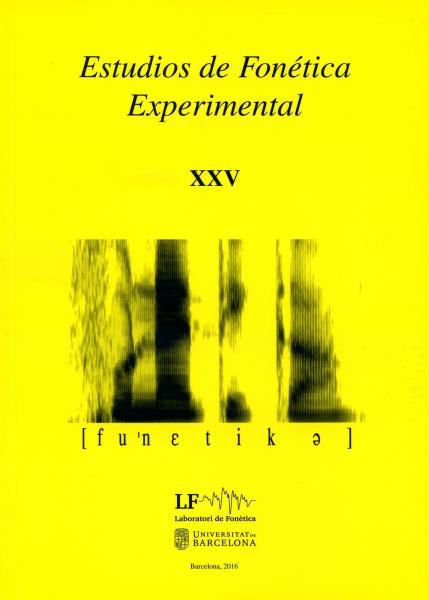Melodic patterns in orders and petitions through an automatic intonation analysis
Keywords:
acoustic and perceptual phonetics, intonationAbstract
This paper analysed intonation in orders and petitions in Chilean Spanish through a completely automated algorithm programmed in Matlab, which works with intonation phonetic features without analysing it phonologically. The results show that three features allow to characterize the intonation of orders and petitions: duration, semitones range and a sequence of tonal movements. Duration in petitions is larger than in orders, the range in semitones is larger in orders than in petitions and orders more often present an affirmative pattern. Contrastively, petitions present a curve that begins with a fall and ends with a steady curve. The algorithm and the results can be used to, for example, create didactic material to teach intonation.
References
ÁLVAREZ, G. (2005): «Contornos de entonación en el discurso de una docente: su relación con algunos aspectos pragmáticos», Onomázein, 11, 2005/1, pp. 67-85.
BOERSMA, P. (1993): «Accurate short-term analysis of the fundamental frequency and the harmonics-to-noise ratio of a sampled sound», Proceedings, 17, pp. 97-110.
BOERSMA, P. y D. WEENINK (2013): Praat: doing phonetics by computer, Versión 5.3.53. http://www.praat.org/ [09/07/2013]
BRAVO, D. (2005): Hacia una redefinición de la “cortesía comunicativa”. Estudios de la (des)cortesía en español, Estocolmo, Dunken.
BROWN, P. y S. LEVINSON (1987): Politeness: Some universals in language usage, Cambridge, Cambridge University Press.
CANTERO, J J. (2002): Teoría y análisis de la entonación, Barcelona, Edicions de la Universitat de Barcelona.
CASTRO, L; B. SERRIDGE, J. MORAES y M. FREITAS (2010): Characterizing variation in fundamental frequency contours of profesional speaking styles, Universidade Federal do Rio de Janeiro, Rio de Janeiro.
D’ERRICO, J. (2004): In_paint_nans.m (Código Matlab). http://www.mathworks.com/matlabcentral/fileexchange/4551-inpaintnans [09/07/2013]
DEVIS, E. y M. BARTOLI (2014): «El aprendizaje de la entonación (des)cortés en español lengua extranjera (ELE)», Porta Linguarum, 21, pp. 245-263.
ESCANDELL, M. (1996): Introducción a la pragmática, Barcelona, Ariel.
ESTRUCH, M; J. GARRIDO, J. LLISTERRI y M. RIERA (1996): «Una aproximación fonética al estudio de la entonación», Philologia Hispalensis, XI, pp. 281-293.
FUENTES, M. (2012): Análisis fonético-acústico de la conducta prosódica de los enunciados del tipo imperativo (petición y orden) del español de Santiago de Chile, Pontificia Universidad Católica de Chile, Santiago de Chile.
GARRIDO, J. (1991): Modelización de patrones melódicos del español para la síntesis y el reconocimiento, Universitat Autònoma de Barcelona, Bellaterra.
GARRIDO, J. (2003): «La escuela holandesa: el modelo IPO», en P. Prieto (ed.): Teorías lingüísticas de la entonación, Barcelona, Ariel, pp. 97-122.
GIL, J. (2007): Fonética para profesores de español: de la teoría a la práctica, Madrid, Arco Libros.
HIDALGO, A. (2013): «La fono(des)cortesía: marcas prosódicas (des)corteses en español hablado. Su estudio a través de corpus orales», Revista de Lingüística Teórica y Aplicada, 51, pp. 127-149.
MATLAB (2010): Matlab versión 7.10.0 (R2010a), The MathWorks Inc, Natick, Massachussetts.
NAVARRO TOMÁS, T. (1918): Manual de entonación española, Nueva York, Hispanic Institute, 19663.
OROZCO, L. (2005): Peticiones corteses y factores prosódicos, El Colegio de México.
ROLDÁN, Y. (2000): «Correlatos acústicos de actos de habla atenuados del español de Chile», Onomázein, 5, pp. 107-118.
SEARLE, J. (1979): A taxonomy of illocutionary acts. Expression and Meaning, Cambridge, Cambridge University Press.
‘T HART, J; R. COLLIER y A. COHEN (1990): A perceptual study of intonation. An experimental phonetic approach to speech melody, Cambridge, Cambridge University Press.
Downloads
Published
How to Cite
Issue
Section
License

This work is licensed under a Creative Commons Attribution-NonCommercial-NoDerivatives 4.0 International License.
All articles published online by Estudios de Fonética Experimental are licensed under Creative Commons Attribution-NonCommercial-NoDerivs 4.0 International (CC BY-NC-ND 4.0 DEED), unless otherwise noted. Estudios de Fonética Experimental is an open access journal. Estudios de Fonética Experimental is hosted by RCUB (Revistes Científiques de la Universitat de Barcelona), powered by Open Journal Systems (OJS) software. The copyright is not transferred to the journal: authors hold the copyright and publishing rights without restrictions. The author is free to use and distribute pre and post-prints versions of his/her article. However, preprint versions are regarded as a work-in-progress version used as internal communication with the authors, and we prefer to share postprint versions.




